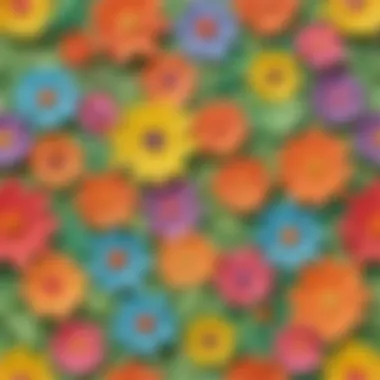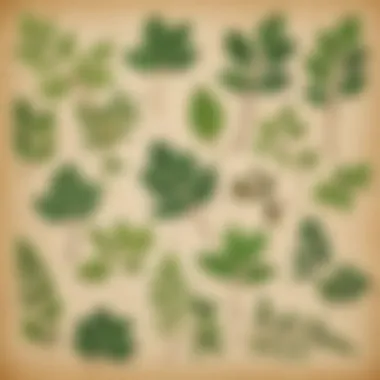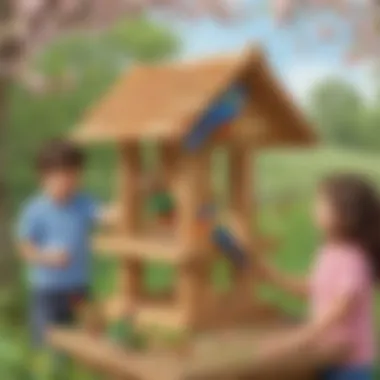Springtime Crafts for Pre-K: Fun Activities for Kids


Intro
Spring is a vibrant season, full of life and color. It brings a wonderful opportunity to engage young learners in activities that spark their creativity. Crafting is a powerful tool for children, as it nurtures fine motor skills while enhancing problem-solving abilities. Moreover, springtime crafts themed around the season can cultivate an understanding of nature and its cycles. Through various engaging activities, children can express themselves and explore their environment in a hands-on manner.
Such seasonal undertakings hold more than just entertainment value; they carry significant educational benefits. The crafts can improve hand-eye coordination and foster cooperation among peers when done in group settings. Parents and educators alike can draw from popular springtime themes, like flowers, insects, and rainbows, to provide meaningful experiences for young learners.
In this article, several craft ideas will be shared, including detailed step-by-step instructions. This guide seeks to empower caregivers and teachers, facilitating a medium for children to create, learn, and appreciate spring.
Creative Activities
Crafting is not just a pastime; it is a wonderful platform for learning. Children in Pre-K can engage in a variety of arts and crafts that reflect spring. These activities are accessible and easy to replicate, ensuring that both adults and young children can create wonderful projects together.
Craft Ideas
- Flower Collage: Children can use colored paper to cut out flowers and glue them onto a larger sheet. This simple activity sparks creativity and a visual understanding of shapes.
- Butterfly Puppets: From paper plates, children can create colorful butterfly puppets. They may use markers and crayons to add details, which allows for a personal touch in their creations.
- Nature Mobile: Collect twigs and leaves, then let children string them together to hang above their learning area. This activity connects them with nature and enhances tactile experiences.
Step-by-Step Guides
Each of these crafts can be explained in easy steps:
- Flower Collage:
a. Gather colored papers, scissors, and glue.
b. Demonstrate how to cut different shapes of flowers.
c. Show how to arrange and glue the flowers on a larger paper. - Butterfly Puppets:
a. Take a paper plate and cut it down the middle.
b. Color the paper with crayons or markers.
c. Attach sticks or straws as handles for puppet play. - Nature Mobile:
a. Find various twigs and leaves outdoors.
b. Create a simple mobile structure with the found items. c. Hang it in a place to observe nature closely.
Educational Value
Springtime crafts carry substantial educational benefits. Creating projects improves fine motor skills as children manipulate materials properly. They also learn about colors, shapes, and measurements throughout various stages of crafting. Beyond technical skills, these activities also support creative thinking. Early engagement in artistic tasks prepares children for future challenges in their academic journeys.
“Crafting is a way to discover both nature and creativity, fostering deeper connections in learning.”
While more complex tasks might incorporate additional skills, even simple crafts can significantly impact a child’s development. The interactivity of crafts allows children to ask questions, explore answers, and learn collaboratively.
In nurturing creativity through crafting, we open up pathways for curiosity and learning. The guiding nature of art fosters a sense of accomplishment and pride, important traits in any pre-kindergarten environment.
The Importance of Crafting in Early Childhood
Crafting holds a significant place in early childhood education. It fosters creativity, promotes problem-solving skills, and encourages young learners to express themselves. Crafting offers children the chance to engage actively with materials and concepts. Each creation becomes a channel of personal expression and discovery. From hands-on activities, children gain valuable experiences that are viely relevant in their growth.
Cognitive Development Through Crafting
Crafting enhances cognitive development in multiple ways. When children engage in craft activities, they practice critical thinking. This is evident when they decide how to arrange materials or envision their projects. For example, children plan every step, focusing on the desired outcome. This not only sharpens their ability to think critically but also teaches them foundation skills for life.
Additionally, crafting often requires following instructions. When children learn to read and interpret directions, they strengthen their comprehension skills. As they follow steps to create, they build dexterity and awareness of spatial relationships. Moreover, the repetition found in repeated crafting activities helps solidify learning, aiding in concept retention.
Social Skills Enhanced by Group Crafting
Crafting frequently happens in groups. This unique environment provides an excellent opportunity for children to develop social skills. Working together on craft projects teaches cooperation and enhances communication. When children share materials or negotiate different ideas for their creations, they learn to express themselves while considering others' viewpoints. These interactions are invaluable. They allow children to bond over common interests and experiences.
During group crafting, children often learn to resolve conflicts when disagreements arise over project ideas. This fosters empathy and patience, essential traits as they grow. Sharing completed projects also builds self-esteem and a sense of community. When children notice others appreciate their work, it reinforces their capabilities while energizing group morale.
Fine Motor Skills and Crafting
Fine motor skills develop through various crafting activities. These skills are vital as they lay the groundwork for tasks such as writing and self-care tasks like buttoning clothes. Activities involving cutting, gluing, or manipulating small pieces necessitate hand-eye coordination and dexterity. Each craft project offers new opportunities for these skills to flourish.
For instance, tearing paper or drawing with crayons helps enhance gripping abilities. Additionally, intricate tasks teach careful touch and control, which may significantly influence handwriting skills in the future. Children are more engaged in these activities than they might be in traditional learning experiences and, thus, more likely to practice until proficient.


Springtime Themes for Inspiration
Spring is a vital time for young learners to experience the blooming of nature and the progression of seasons. These themes serve as an inspiration for crafting activities, allowing children to explore their environment more deeply. A focus on springtime prompts creatives and imaginative expression, paving the way for not only fun but educational moments. By emphasizing plants, animals, and weather changes, children can learn fundamental concepts linked to biology, ecology, and the atmosphere—all while engaging in productive crafting. The integration of these themes encourages a multi-faceted educational experience through creativity and play.
Flora: Flowers and Plants
Flowers represent beauty and growth, making them perfect themes for crafting activities. At this stage of development, engaging with flora enables children to build crucial observation skills and understand the world around them. Craft ideas centered around flowers help them visualize different shapes, colors, and textures. Handprint flowers or paper plate arrangements contribute to sensory experience and allow exploration of basic plant responsibilities in nature. Young learners can decipher how seasons affect flora, fostering curiosity inspired by the cycle of life.
Easy Flower Crafts
- Handprint Flowers: Using paint for handprints allows children to create unique flower blooms. This connects personal experiences to crafting.
- Tissue Paper Flowers: With simple layers of colorful paper, children can craft their own small bouquets. It encourages manipulation and awareness of material texture.
Through engaging activities about plants, children also start recognizing the role of nature, fostering a healthier relationship with their environment.
Fauna: Animals of Spring
The world of fauna is equally compelling when addressing spring themes. Spring signifies new life in the form of various animals, especially birds and baby creatures. Craftt activities themed around animals offer the chance for storytelling through visuals, enhancing understanding of life cycles and animal behavior. For example, crafting chick figures or butterfly origami allows children to explore species and their habits, fostering imaginative play. The excitement of springtime animals enhances social interactions as children awe and wonder at the beauty of life coming back.
Engaging Animal Crafts
- Egg Carton Chicks: This transforms simple materials into delightful representations of baby animals. Encouraging recycling brings in eco-friendliness.
- Origami Butterflies: Creating colorful wings provides a hands-on experience while enhancing dexterity.
Integrating such crafts into learning rituals supports positive exchanges amongst peers as they reflect on their findings together.
Weather: The Changing Season
Weather is a major aspect of spring and holds the key to understanding environmental changes. By exploring crafting projects centered on the new weather situations in spring, children gain insights into climate observation and adaptation. Activities like creating paper plate suns or clouds with cotton help visualize the concepts practically, teaching them about sunny days and rain which stimulate growth in plants.
Fun Weather Crafts
- Paper Plate Suns: Children can cut and color to create suns which serve as reminders of warmer temperatures.
- Rain Sticks or Slime for Showers: Simple tools can illustrate the rain’s usefulness in nature while being entertaining to create.
These activities will assist children in approaching sciences related to earth and climate early on, reinforcing their observations through hands-on experience.
Crafting with seasonal themes not only boosts creativity but also nurtures key developmental benefits.
Craft Ideas for Pre-K Children
Craft activities play a vital role in early child development, especially in a pre-kindergarten setting. Engaging young learners in hands-on creative projects can stimulate their imagination and enhance their fine motor skills. In addition, these activities encourage children to express themselves while also fostering a spirit of cooperation and teamwork in group settings. Creating crafts during springtime allows educators and caregivers to integrate elements of the season, enhancing learning experiences with age-appropriate projects that are engaging and worthwhile.
Handprint Flowers
Materials Needed
The materials chosen for crafting can greatly affect not just the outcome, but also the process. For creating handprint flowers, simple items like colored construction paper, washable paint, and markers are crucial. Colored construction paper allows children to work with vibrant colors that enhance their creativity. Washable paint is ideal as it ensures that cleaning up afterward is simple, causing less stress for both the caregivers and the children. These materials are safe, relatively mess-free, and easy to handle, which makes them a popular choice in classroom settings.
Step-by-Step Instructions
The step-by-step instructions must be clear and easy for young learners to follow. Start by guiding the children to dip their hands into washable paint. This tactile experience offers sensory input that can be beneficial for young children. After they press their painted hands onto construction paper, they can add details with markers to decorate the flowers. These instructions teach the children simple sequencing skills while igniting their creativity. Small variations can help to develop unique art pieces tailored to each child's preferences, making the process enjoyable for all.
Paper Plate Suns
Materials Needed


For the paper plate suns, commonly used materials include basic office supplies like scissors, glue, and yellow, orange, and red construction paper. Paper plates serve as a wonderful base for crafting because they are strong enough to handle various creative adjustments without tearing. These materials allow children to create vibrant and cheerful representations of the sun. Using materials that are familiar helps keep engagement high and provides opportunities for exploration while cultivating environmental awareness through fun.
Step-by-Step Instructions
Crafting should not be complex for young children. In this case, the step-by-step instructions begin with using scissors to cut edges of the paper plate for rays. This enhances their fine motor skills while ensuring they are learning as they play. Thereafter, children can glue on pieces of colored construction paper around the plate to form radiant sun rays. The ease of these steps ensures an enjoyable experience, allowing children the freedom to add personal touches.
Origami Butterflies
Materials Needed
When creating origami butterflies, lightweight paper is essential. Origami paper is favored, as its thinness makes it easier to fold and shapes intricately, which results in visually appealing crafts. Light shades or patterns often attract children’s attention, creating a playful sense of attraction towards the project. Using origami helps children understand geometry and spatial relationships, contributing to their overall cognitive development.
Step-by-Step Instructions
The instructions for origami butterflies provide a challenge tailored to the skill levels of young learners. Each fold introduces children to new techniques that sharpen their dexterity. Children should be guided carefully through each step, allowing corrections if needed. Completing an origami can offer them an exhilarating sense of accomplishment, showcasing their independence and enhancing self-esteem through the act of creation.
Nature Collage
Materials Needed
Utilizing natural materials can enrich a child's experience through a nature collage. Materials such as leaves, flowers, and twigs are vital. Collecting these items offers an opportunity for outdoor exploration, connecting the crafting activity to the environment. Natural textures enhance sensory discovery and creativity. Although some materials might become sparse depending on local flora, collection can be a critical early lesson on ecology, appreciation, and respect for nature.
Step-by-Step Instructions
Steps in crafting a nature collage include laying out the collected materials and deciding how to arrange them on paper. Children refine their abilities by practicing observation and dexterity. They glue nature items onto a larger sheet and perhaps add drawings to complete their art. This sequence allows for discussion about shapes, forms, and ecology, providing educational value alongside creative expression.
Egg Carton Chicks
Materials Needed
Egg cartons present a great resource as they are often found at home after purchasing eggs. This approach emphasizes resourcefulness and sustainability in crafting, appealing to caregivers' and educators' interests in green initiatives. Adding colored paint and crafty eyes creates lively representations of chicks. The charm of these materials lies in how they are accessible while allowing creativity in redesign.
Step-by-Step Instructions
To make egg carton chicks, children first cut out individual sections then shape them as desired. Painting brings them to life, fostering initiative and choices among the kids. Providing successive steps helps children develop their ability to follow directions. The enticing results provide joy and stimulate discussion about springtime themes.
Spring-Themed Playdough Mats
Materials Needed
Using playdough mats during crafting garners interest among pre-kindergarten children. Simple motifs like flowers, rays of the sun, and animals help them engage further with both sculpting and sensory work. Soft, colorful playdough serves as tactile material. It is common, inexpensive, and fun, inviting children to express creativity while working on their hand strength and manipulation skills.
Step-by-Step Instructions
The instructions involve laying out various spring-themed images outlining the design, which guides children to mold various playdough shapes according to images. This method encourages imaginative thinking as children recreate themes while practicing finger dexterity. Flexibility in how children make their images can foster diversity in creative expression.
Apart from enjoying a range of activities, crafting in spring helps children connect concepts across multiple domains enriching their educational play. Crafting seasonal art provides an excellent integration of learning and creativity throughout pre-kindergarten education.
Integration of Crafting into Curriculum
Crafting in early education is not just about making objects. It plays a significant role in enhancing various aspects of the curriculum. By integrating crafting, educators provide children with hands-on learning experiences. These experiences stimulate curiosity and encourage a deeper understanding of concepts across different subjects.
Crafts and Language Development


Arts and crafts can also support language development in young children. During crafting activities, children can practice vocabulary related to shapes, colors, and materials. By describing their process, they learn to articulate their thoughts clearly. Discussions around their crafted pieces promote language skills as they interact with peers and adults.
Young ones learn best through communication. For example, pairing a simple crafting task with storytelling can lead to richer vocabulary acquisition. While making paper plate suns, children might discuss the sun’s colors, its importance, and even share any related story. This monumental interaction aids their language growth.
Math Concepts Through Crafting
Crafting articles serve to introduce mathematical concepts in a tangible and enjoyable manner. Counting, measuring, and sorting become evident when children gather materials for a project. For instance, while creating star-shaped decorations, they can learn to count each point of the stars.
The activity can incorporate geometric shapes. Free-form cuttings help children recognize various shapes and understand simple patterns. The practice reinforces their mathematical understanding. These activities provide a playful environment, cultivating a natural curiosity towards mathematical thought processes.
Incorporating Science in Crafts
Craft activities are perfect opportunities to introduce scientific concepts. Depending on the project, children can discuss properties like texture and color. For example, while producing a nature collage, they explore the differences between the leaves' textures or colors while learning about plant types.
Additionally, some crafts can incorporate simple physics. Children can create simple marble runs, manipulating various materials to observe how gravity works. Encouraging experimentation leads to inquiry-based learning—a cornerstone in science education.
Integrating science in crafting not only enriches their understanding but cultivates critical thinking skills valuable for future learning.
Overall, these crafting activties lay a solid foundation for essential skills that will help the kids be prepared for ongoing campus initiatives and personal growth.
Safety Considerations for Young Crafters
Crafting with young children brings joy and creativity, but safety must always be a priority. In this section, we will discuss significant considerations that emerge when engaging pre-kindergarten children in crafting projects. Understanding safety in crafting not only ensures a pleasant experience but also fosters an environment where kids feel secure to explore their imagination.
Choosing Age-Appropriate Materials
When selecting crafting materials for young learners, it is crucial to choose age-appropriate options. This choice not only ensures safety but also enhances the effectiveness of the crafting experience.
- Non-Toxic Supplies: Always opt for non-toxic, water-based glues and paints. Young children tend to have a natural inclination to put things in their mouths, so materials should pose no health threats.
- Avoid Small Parts: Crafts that utilize small pieces, such as beads or buttons, can present choking hazards. Always ensure that all materials fit the choke-test guidelines, avoiding anything smaller than a AA battery.
- Durability: Young children can be rough with materials. Choose items that can withstand handling, like thick construction paper and durable scissors designed for preschoolers.
Incorporate these material considerations into your planning. For instance, when setting up craft stations, place age-appropriate materials within easy reach to promote independence while maintaining safety.
Supervising Craft Activities
Supervision during crafting is vital due to the innate curiosity and energetic movements of young children. Active involvement ensures safety, promotes positive interactions, and aids in effective guidance through various crafting steps.
- Present Techniques: Teach children the correct way to use tools with clear demonstrations. For instance, show them the proper way to grip scissors. Demonstrations build confidence and competence.
- Engagement: Participate alongside children as they craft. This not only helps in monitoring their play but also provides opportunities to offer real-time guidance.
- Create a Safe Environment: Ensure that the crafting space is free of any clutter, sharp objects, and potentially dangerous tools. Keep hazardous materials secure and out of reach.
“It’s paramount to ensure a friendly and encouraging environment. This can effectively spark joy and support their artistic endeavors.”
Supervision is not merely about watching; it encompasses engaging with children, reinforcing rules, and enhancing their understanding of crafting through safe practices. The aim is to cultivate an atmosphere rich in exploration while tightly aligned with safety protocols.
Epilogue and Future Crafting Ideas
Crafting is a significant component of early childhood education. It helps young learners harness their creativity while developing essential skills. Concluding this exploration of springtime crafts, it is vital to reflect on not just the activities themselves, but also the learning potential they unlock. Engaging in craft projects tailored to seasonal themes aids in recognizing patterns, enhancing fine motor skills, and cultivating social interactions among peers.
Reflecting on Crafting Experiences
When children complete a craft project, they gain invaluable insights. This process encourages them to look back at what they have made, understanding their journey of creation. Reflecting on their crafting experiences helps kids comprehend the outcomes of their actions.
- It encourages discussions about what went well.
- They learn to articulate challenges faced during crafting.
- Kids begin to appreciate the time and effort that went into the activities.
By guiding children through this reflection process, educators and caregivers strengthen their capability to process information and enhance their communication skills. This practice goes a long way in building self-esteem and boosting their willingness to engage in future projects, both in and out of the classroom.
Resources for Continued Crafting
Continuity in crafting allows young learners to develop skills over time. Access to resources can transform a simple project into an ongoing learning experience. Here are a few valuable resources:
- Books: There are many craft books designed specifically for young crafters that provide numerous ideas suitable for different skill levels and interests. Books like Crafty Critters or Creative Crafts for Kids often encourage systematic approaches to activities.
- Websites: Some websites offer excellent ideas and step-by-step guides for crafting activities suited for young learners. Forums on platforms like Reddit can also provide shared experiences from other parents and caregivers, expanding the pool of creative options.
- Local Community Events: Keep an eye on community centers, libraries, and schools for workshops or classes. These often provide hands-on experiences that nurture further crafting excitement.
Ultimately, the journey of crafting does not have to end with spring but should integrate into daily life. Giving kids the tools they need to craft, create and reflect ensures that the spirit of creativity thrives well beyond the classroom. Emphasizing continuous projects cultivates an enthusiastic mindset towards learning that lasts. Utilize all available resources for fostering an ongoing engagement with crafting. With each new season, let new crafting ideas flourish.







